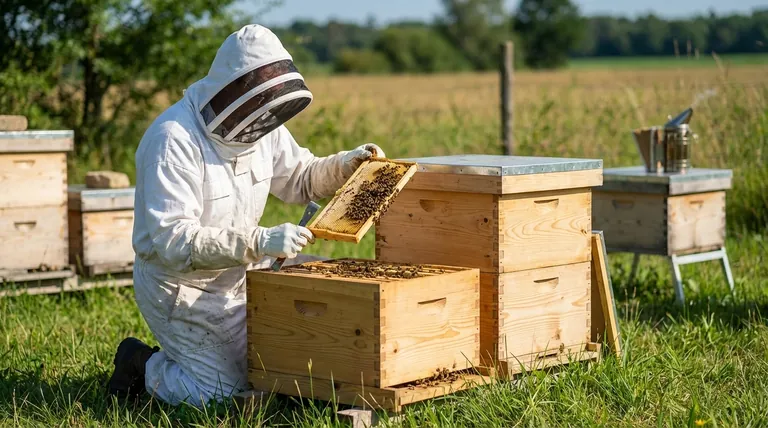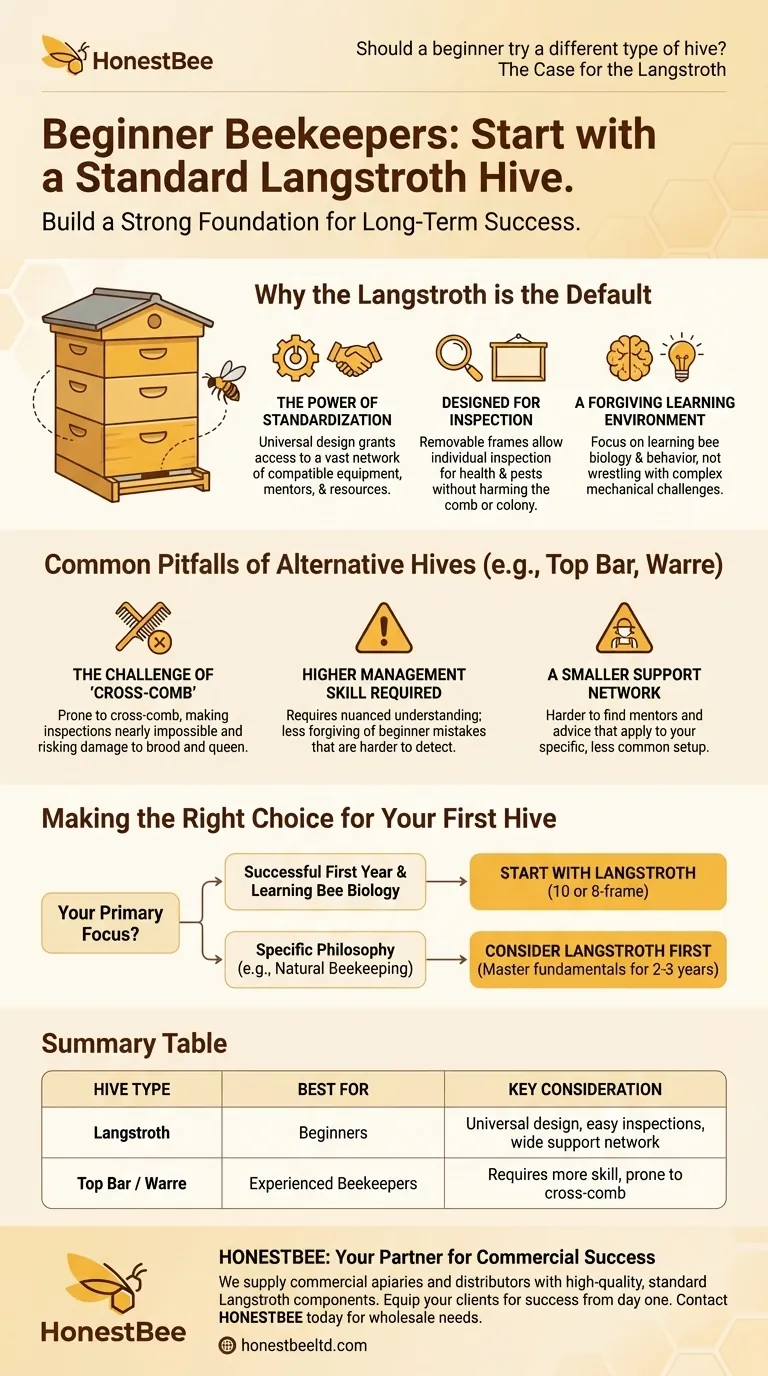For new beekeepers, the recommendation is clear: You should begin your journey with a standard Langstroth hive. While other hive designs have unique benefits, the Langstroth is specifically engineered to minimize complexity and provide a forgiving environment for learning. This isn't about limiting your options, but about setting a strong foundation for long-term success.
The decision to start with a Langstroth hive is less about the hive's inherent superiority and more about its ecosystem. Its universal design grants beginners access to the widest possible network of compatible equipment, mentors, and educational resources, dramatically simplifying the learning curve.

Why the Langstroth is the Default for Beginners
The widespread adoption of the Langstroth hive is rooted in its practical, management-focused design. It systematically solves problems that can quickly overwhelm a novice beekeeper.
The Power of Standardization
The Langstroth is the most popular hive design in the United States and many parts of the world. This creates a powerful network effect.
As a beginner, this means you can easily find compatible boxes, frames, and other equipment from any supplier. More importantly, you can find local mentors and beekeeping clubs who understand your setup and can offer relevant, actionable advice.
Designed for Inspection and Management
The core innovation of the Langstroth hive is the removable frame. These frames are built to a specific dimension that respects "bee space."
This design allows you to pull out individual frames to inspect for pests, diseases, and the health of your queen without destroying the comb or harming the bees. This level of control is invaluable when you are learning to read a colony.
A Forgiving Learning Environment
By using a standardized, manageable system, you can focus your attention on the most important thing: learning bee biology and behavior.
You can spend your time understanding the brood cycle and identifying nectar flows instead of wrestling with the unique mechanical challenges presented by less common hive types.
Common Pitfalls of Alternative Hives for Beginners
While hives like the Top Bar or Warre are excellent for experienced keepers with specific goals, they present distinct challenges that can be frustrating and even detrimental for a novice.
The Challenge of "Cross-Comb"
Hives without rigid frames are prone to cross-comb, where bees build their comb across multiple top bars instead of parallel to them.
For a beginner, this creates a critical problem. It makes inspections nearly impossible without cutting through comb, destroying brood, spilling honey, and risking injury to the queen. Fixing cross-comb requires a level of skill most beginners do not yet possess.
Higher Management Skill Required
Successfully managing a non-Langstroth hive requires a more nuanced understanding of bee behavior to anticipate and prevent problems.
These hives are less forgiving of mistakes. The easy access provided by a Langstroth frame allows you to correct issues, while a problem in another hive type might not be discovered until it is too late.
A Smaller Support Network
Choosing a less common hive immediately shrinks your support system. It becomes harder to find experienced mentors, and advice from the majority of books, videos, and beekeeping groups may not apply directly to your setup.
Making the Right Choice for Your First Hive
Your first hive is a tool for learning. The goal is to choose the tool that removes the most obstacles and allows you to build a solid base of knowledge and experience.
- If your primary focus is a successful first year and learning bee biology: Start with a 10-frame or 8-frame Langstroth hive to leverage the vast support system and forgiving design.
- If your primary focus is a specific philosophy (e.g., "natural" beekeeping): Still consider starting with a Langstroth for two to three years to master the fundamentals before transitioning to a hive that better aligns with that philosophy.
Choosing your first hive is about selecting the best tool to build your foundational confidence as a beekeeper.
Summary Table:
| Hive Type | Best For | Key Consideration |
|---|---|---|
| Langstroth | Beginners | Universal design, easy inspections, wide support network |
| Top Bar / Warre | Experienced Beekeepers | Requires more skill to manage, prone to cross-comb |
Ready to start your beekeeping journey with confidence?
At HONESTBEE, we supply commercial apiaries and beekeeping equipment distributors with the high-quality, standard Langstroth hive components that make learning beekeeping easier. Let us equip you for success from day one.
Contact HONESTBEE today to discuss your wholesale needs and build a strong foundation for your apiary.
Visual Guide

Related Products
- Langstroth Bee Hives Bee Keeping Box for Beginners Beekeeping
- Long Langstroth Style Horizontal Top Bar Hive for Wholesale
- HONESTBEE Professional Multi-Functional Hive Tool with Ergonomic Wood Handle
- HONESTBEE Professional Long Handled Hive Tool with Precision Cutting Blade
- Professional Dual-End Stainless Steel Hive Tool for Beekeeping
People Also Ask
- What is the best type of bee hive for beginners? Start with the Proven Langstroth Standard
- What are the key features of the Langstroth beehive? A Guide to the Standard for Modern Beekeeping
- Why are Langstroth hives recommended for beginners? Unmatched Support & Standardization
- Why were wooden hives traditionally preferred? For Natural Beekeeping Aligned with Bee Biology
- How does the ease of access differ between 8-frame and 10-frame hives? Choose the Right Hive for Your Body



















